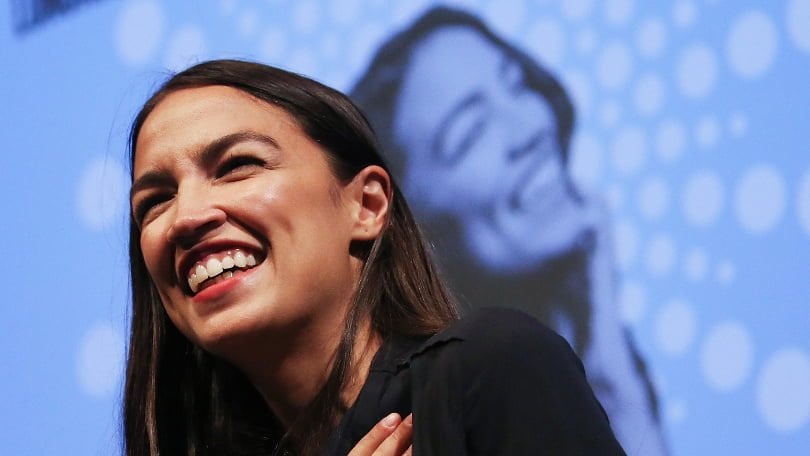Ocasio Cortez Heritage
Alexandria Ocasio-Cortez told a Jewish group in New York she is Jewish, too. The 29-year-old former bartender claimed for the first time publicly on Sunday that she has Jewish ancestry while speaking during a Hanukkah event in her home borough of Queens. When she went on to explain her new Jewish heritage, something went wrong and then the New Yorker got a nasty surprise. Don't miss this. And while Ocasio-Cortez may not have attempted to affiliate, her desire to proclaim her heritage may also mirror a larger phenomenon inside the Jewish community—the phenomenon of individuals whose Jewishness was little more than ascription who, today, explore new ways of affiliation, even if not in any religious context—an event called “disassimiliation” by sociologists. Ocasio-Cortez went on to speak of how Catholicism, Judaism, and other religions or spiritualisms, including African animalism, mixed together to make something 'entirely distinct' for those living. Heritage Expert’s Exchange with Rep. Ocasio-Cortez Draws Attention to Paid Family Leave Policy December 12th, 2019 Heritage Foundation policy expert Rachel Greszler testified before Congress on.
© Melina Mara/The Washington Post via Getty Images Rep. Alexandria Ocasio-Cortez of New York shows her fearlessness through her style. Melina Mara/The Washington Post via Getty Images- Democratic Rep. Alexandria Ocasio-Cortez of New York made history as the youngest female member of Congress when she was elected at age 29 in 2018.
- Since then, she's established herself as a vocal political leader with a bold sense of style that amplifies her messages.
- Ocasio-Cortez was recently named one of fashion search engine Lyst's Power Dressers of 2020 alongside pop-culture icons like Lizzo, Beyoncé, and Harry Styles.
- Ocasio-Cortez has consistently shown that having fun with style doesn't detract from her power, and that fashion can be a tool to inspire the next generation of leaders.
- Visit Insider's homepage for more stories.
Democratic Rep. Alexandria Ocasio-Cortez was recently named as one of the fashion search engine Lyst's Power Dressers of 2020 alongside celebrities like Harry Styles, Beyoncé, and Lizzo.
The lawmaker's recognition among pop-culture icons shows that people know her not only for her policies - and as the youngest woman to be elected to US Congress - but also as a fashion rule-breaker with an inspiring approach to style.
Since being sworn into the House of Representatives in 2019, Ocasio-Cortez has used her style to amplify her political views, prove that having fun with fashion doesn't detract from her power, and empower the next generation of leaders.
AOC has leaned into fashion to amplify what she stands for in Congress
When she joined the House of Representatives in January 2019, Ocasio-Cortez celebrated her heritage and paid homage to female political figures who came before her in one of the first major fashion statements of her career.
© Chip Somodevilla/Getty Images Ocasio-Cortez takes the oath during the first session of the 116th Congress at the US Capitol on January 3, 2019. Chip Somodevilla/Getty ImagesShe paired a white suit - potentially a nod to suffragettes who wore the bright hue in marches fighting for women's right to vote - with hoop earrings and red lipstick, which she later said were inspired by Supreme Court Associate Justice Sonia Sotomayor.
—Alexandria Ocasio-Cortez (@AOC) January 4, 2019
Einav Rabinovitch-Fox, a visiting assistant professor of history at Case Western Reserve University who has previously written about Ocasio-Cortez's fashion choices, told Insider that the lawmaker's outfit seemed to set the tone for future statements she has gone on to make.
'The fact that she wore hoop earrings was a statement of, 'Yes, you're not used to seeing people like me in the House, and I'm putting it in your face,' Rabinovitch-Fox said. 'To me, her style is her way of saying that her Latinx heritage and upbringing as a 'girl from the Bronx' has a place in Congress.'
In February 2019, Ocasio-Cortez joined several of her Democratic colleagues in wearing suffragette white to the State of the Union address. Ocasio-Cortez's white caped blazer, which appeared to be a style from Zara, drew major interest on social media. Aside from being a stylish outfit, it may have held some symbolism of its own, according to Rabinovitch-Fox.
'The cape jacket for the State of the Union address was sort of an image of a superhero. It was very Hollywood-y and very powerful,' Rabinovitch-Fox said.
© Win McNamee/Getty Images; Alex Wong/Getty Images Ocasio-Cortez isn't afraid to make style statements - from wearing a bold-red lip color to showing a sense of humor with her clothes. Win McNamee/Getty Images; Alex Wong/Getty ImagesSome of Ocasio-Cortez's symbolic fashion choices seem to be more literal - such as the emerald-green suit she wore to introduce the Green New Deal resolution press conference in 2019.
Other times, Ocasio-Cortez's clothes seem to match her tone or messaging in a way that's more subtle, but equally striking.
In a July hearing, Ocasio-Cortez responded to Republican Rep. Ted Yoho of Florida for verbally accosting her outside the steps of Capitol Hill and calling her a 'f---ing b----,' an exchange that was first reported by The Hill.
Wearing a scarlet-red blazer and matching lipstick, Ocasio-Cortez took the floor to condemn the speech that Yoho had reportedly used. According to data from Lyst, searches for red blazers increased by 74% in the five days following Ocasio-Cortez's hearing.
_(cropped).jpg/170px-Alexandria_Ocasio-Cortez_%40_SXSW_2019_(46438132055)_(cropped).jpg)
—CSPAN (@cspan) July 23, 2020
Ocasio-Cortez's bold blazer wasn't only eye-catching; it also seemed to amplify the lawmaker's speech, according to Kate Haulman, an associate professor at American University who teaches early North American and US history as well as women's and gender history.
'Red becomes so associated with the Republican party, and also because of the 'MAGA' hats,' Haulman told Insider. 'I thought it was her way of saying, 'I'm reclaiming this color.' It was such a vibrant shade, too. I thought it was a real statement.'

Ocasio-Cortez later addressed wearing red during her hearing, telling Vanity Fair's Michelle Ruiz that she 'had a little war paint on that day.'
Alexandria Ocasio Cortez Polls
Ocasio-Cortez shows that taking an interest in fashion and being taken seriously aren't mutually exclusive
While Ocasio-Cortez is not the first or the only female political figure throughout history to use style intentionally, she's certainly one of the first members of Congress to give a makeup tutorial on YouTube and show fans what she carries in her trendy tote bag.
In a video for Vogue's 'Beauty Secrets' series, which typically documents the beauty regimens of influencers, actors, and models, Ocasio-Cortez revealed her skin-care and makeup routine and showed off her go-to red lip color: Stila's Stay All Day Liquid Lipstick in 'Beso.'
'I feel a little more oomph with the red on,' the lawmaker told Vogue viewers as she applied the product in the mirror.
Ocasio-Cortez has given similar glimpses into her sense of style that show even congresspeople can be trendsetters.
In August, Ocasio-Cortez was pictured outside the US Capitol Building carrying a Telfar Shopping Bag, a constantly sold-out purse from the New York City-based designer Telfar Clemens. Clemens founded the brand in 2005 in what is now Ocasio-Cortez's congressional district.
The lawmaker later gave her followers on Instagram a look at what she carries inside her Telfar tote to prepare for a hearing, including her iPad, sunglasses for her walk to the Capitol, and a reusable water bottle.

The AOC effect struck again when, the same week of her Instagram story showcasing her Telfar bag, online searches for the purse spiked by 163%, according to Lyst.
© Tom Williams/CQ-Roll Call, Inc via Getty Images AOC wore the Telfar Shopping Bag in the color 'Oxblood.' Tom Williams/CQ-Roll Call, Inc via Getty ImagesWhile some women in political positions avoid making bold fashion statements for fear of distracting from their agendas or being labeled as frivolous, Rabinovitch-Fox said Ocasio-Cortez takes the opposite approach, sending a message to young audiences and constituents that it's possible to embrace fashion and beauty - and still be regarded as a powerful figure.
'With Ocasio-Cortez, style is a tool of power, not a message of: 'Don't reduce me to appearance,' Rabinovitch-Fox said.
According to Haulman, Ocasio-Cortez's fearlessness in her approach to politics and fashion has led her to be viewed as an icon of sorts.
'I think it's the combination of her youth, her style, and the fact that she makes the most of her kind of outsider status in terms of her background that has led her to be so widely talked about,' Haulman said.
© Provided by Business Insider Rep. Alexandria Ocasio-Cortez, D-N.Y., walks up the House steps for a vote in the Capitol on Thursday, Sept. 17, 2020. Bill Clark/CQ-Roll Call, Inc via Getty ImagesAOC is also using fashion to open the door to the next generation of leaders
Ocasio-Cortez's stylish image hasn't just inspired her supporters to get their hands on the trendy Telfar Shopping Bag or rock Stila's liquid lipstick in 'Beso.' Her fashion-forward image has also garnered its fair share of backlash.
The lawmaker is far from the first female political figure to be targeted for what she wears. Because fashion has a historical association with women, Haulman said, females in powerful positions - and on all sides of the political spectrum - have faced criticism for their style, while men in similar positions often don't face the same backlash.
Particularly, people have labeled Ocasio-Cortez as hypocritical for sharing her agenda as a self-identified democratic socialist while being photographed in high-end clothing items. But the lawmaker has been open about renting and thrifting much of her wardrobe.
When Ocasio-Cortez appeared on the cover of Vanity Fair's December issue, she defended herself against commenters who criticized her for wearing luxury-label outfits in the magazine.
On Twitter, Ocasio-Cortez said her clothes were borrowed, as is the case with most clothing used for media appearances and magazine photo shoots.
'Republicans are Very Mad (again) about my appearance,' Ocasio-Cortez wrote in a tweet. 'This time they're mad that I look good in borrowed clothes (again).'
Alexandria Ocasio Cortez Heritage
She had a similar response to critics in February after the New York Post reported the lawmaker wore a $580 Rickie Freeman dress on 'The View' while the same dress in another color was on sale at Saks Fifth Avenue for less at the time.
'Yep! I rent, borrow, and thrift my clothes. (It's also environmentally sustainable!)' Ocasio-Cortez wrote in February on Twitter addressing backlash of the dress she wore on the talk show.
© Jenny Anderson/ABC via Getty Images Rep. Alexandria Ocasio-Cortez on 'The View' in February 2020. Jenny Anderson/ABC via Getty ImagesOcasio-Cortez's openness about where she gets her clothes has seemingly inspired other political figures to do the same with their professional wardrobes.
In November, incoming Democratic Rep. Cori Bush of Missouri wrote about her decision to buy thrifted clothes for her Washington, DC, wardrobe. Ocasio-Cortez offered Bush her tips - including 'thrifting, renting, and patience' - which created a sort of chain reaction as other political figures from around the US and world chimed in on the conversation.
—Alexandria Ocasio-Cortez (@AOC) November 11, 2020
—Grace Meng (@Grace4NY) November 11, 2020
—Marama Davidson MP (@MaramaDavidson) November 11, 2020
Rabinovitch-Fox said that by showing how powerful style statements don't have to be expensive, Ocasio-Cortez is inherently using fashion in a political way.
'She's changing the dress code of politics by making it acceptable for people to wear thrifted clothes in Congress,' Rabinovitch-Fox said. 'But not only that, I think her openness is a statement that Congress is going to look different and more diverse.'
Rabinovitch-Fox added: 'I think that in a sense, her approach to style represents that she's not going to just play the game - she's going to change the rules of the game.'
Representatives for Rep. Alexandria Ocasio-Cortez did not immediately respond to Insider's request for comment.
- Read more: